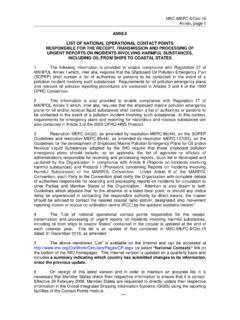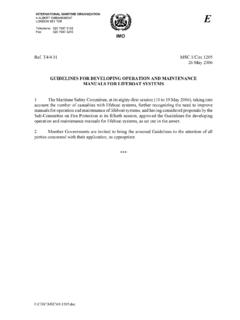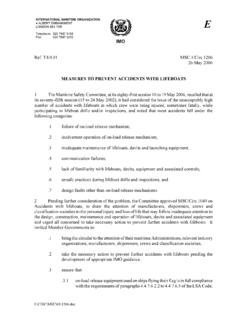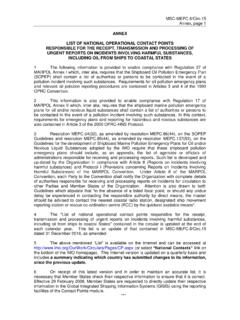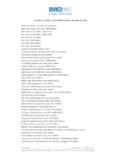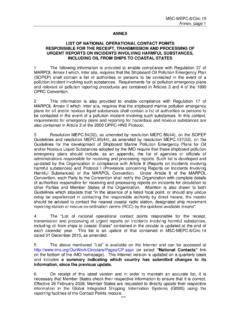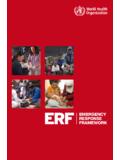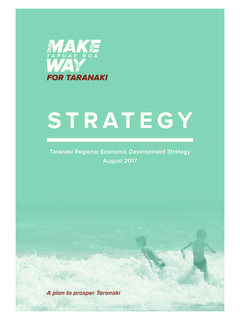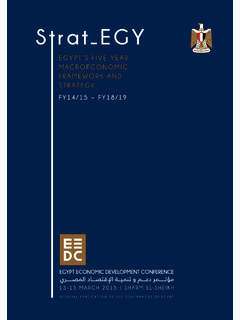Transcription of ANNEX 7 DRAFT E-NAVIGATION STRATEGY …
1 NCSR 1/28. ANNEX 7, page 1. ANNEX 7. DRAFT E-NAVIGATION STRATEGY implementation plan . introduction 1 As shipping moves into the digital world, E-NAVIGATION is expected to provide digital information and infrastructure for the benefit of maritime safety, security and protection of the marine environment, reducing the administrative burden and increasing the efficiency of maritime trade and transport. 2 The E-NAVIGATION STRATEGY implementation plan (SIP) introduces a vision of E-NAVIGATION which is embedded in general expectations for the on board, onshore and communications elements. 3 The main objective of the present SIP is to implement the five prioritized E-NAVIGATION solutions, taking into account the IMO Formal Safety Assessment (FSA), from which a number of required tasks have been identified.
2 These tasks should, when completed in the period 2015 2019, provide the industry with the harmonized information, in order to start designing products and services to meet the E-NAVIGATION solutions. 4 The present SIP identifies the list of tasks which would need to be performed during the coming years in order to achieve the five prioritized E-NAVIGATION solutions. 5 It should be noted that, although the need to use the existing equipment in a more holistic way was identified early on, some onboard equipment may need modifications to interfaces and controls in order to be used. However, in the future, the need for new equipment for the deployment of future E-NAVIGATION solutions and applications cannot be disregarded.
3 6 Tasks listed in the SIP should be incorporated in the High-level Action plan of the Organization as planned/unplanned outputs, taking into account the provisions of the Guidelines on the organization and method of work of the Maritime Safety Committee and the Marine Environment Protection Committee and their subsidiary bodies, as set out in , as may be revised (the Committee's Guidelines). 7 In line with the provisions of the Committee's Guidelines, any further E-NAVIGATION -related work would require the Committee's approval and should be clearly incorporated as planned/unplanned output(s) in the High-level Action plan of the Organization.
4 Therefore, each one of the approved tasks would need to be approved at the same time as a planned/unplanned output, as appropriate, with clear indication of: - IMO's objectives;. - Analysis of the issue;. - Analysis of implications;. - Compelling need;. - Benefits;. - Industry standards;. - The intended output;. - Human element consideration;. - Priority/urgency, including expected target completion year; and - Action required. I:\NCSR\01\ NCSR 1/28. ANNEX 7, page 2. 8 In line with the above, interested Member States may submit proposals to the Committee for the inclusion of new planned/unplanned outputs in the High-level Action plan of the Organization based on the identified tasks contained in this SIP.
5 9 Proposals for the further development of E-NAVIGATION solutions and tasks which are not listed in the SIP may also be submitted by Member States to the Committee for consideration; however priority should be given to the tasks identified in the SIP. 10 Member States willing to lead a specific task should ensure the timely delivery of the task by requesting the assistance of other Member States and/or relevant organizations. STRATEGY implementation plan for the five prioritized E-NAVIGATION solutions 11 The present SIP is based on the following five prioritized E-NAVIGATION solutions: S1: improved, harmonized and user-friendly bridge design.
6 S2: means for standardized and automated reporting;. S3: improved reliability, resilience and integrity of bridge equipment and navigation information;. S4: integration and presentation of available information in graphical displays received via communication equipment; and S9: improved Communication of VTS Service Portfolio (not limited to VTS. stations). 12 Solutions S2, S4 and S9 focus on efficient transfer of marine information and data between all appropriate users (ship-ship, ship-shore, shore-ship and shore-shore). Solutions S1 and S3 promote the workable and practical use of the information and data on board.
7 13 As part of each one of the above prioritized E-NAVIGATION solutions, several sub-solutions were identified. These are illustrated in tables 1 to 5 below. 14 Whilst the first steps involve implementing the five prioritized E-NAVIGATION solutions, it is important to recognize that further E-NAVIGATION development will be a continuous process following user needs for additional functionalities of existing and possible future systems ( implementation of onboard and/or ashore navigational decision support systems). As user needs evolve and new technology is introduced, other E-NAVIGATION solutions may be incorporated into the STRATEGY , as appropriate.
8 15 During the FSA process, the following Risk Control Options (RCOs) were identified in order aid the assessment of the prioritized E-NAVIGATION solutions and some of the sub-solutions: RCO 1: Integration of navigation information and equipment including improved software quality assurance (related to sub-solutions , , , , , , and );. RCO 2: Bridge alert management (related to sub-solution );. RCO 3: Standardized mode(s) for navigation equipment (related to sub-solution );. I:\NCSR\01\ NCSR 1/28. ANNEX 7, page 3. RCO 4: Automated and standardized ship-shore reporting (related to sub-solutions , , and );. RCO 5: Improved reliability and resilience of onboard PNT systems (related to sub-solution ).
9 RCO 6: Improved shore-based services (related to sub-solution and solution S9); and RCO 7: Bridge and workstation layout standardization (related to sub-solution ). 16 A number of necessary actions and tasks have been identified in order to progress the further development and implementation of the five prioritized E-NAVIGATION solutions. These are listed below under each respective solution and consolidated in table 7. Table 1. Required regulatory framework and technical requirements for implementation (tasks). for solution 1 (Improved harmonized and user friendly bridge design). Sub- Description Task Action Task Solution Identifier (Table 7).
10 Ergonomically improved and DRAFT Guidelines on Human Centred T1. harmonized bridge and Design (HCD) for E-NAVIGATION workstation layout. systems. T2. DRAFT Guidelines on Usability testing, Evaluation and Assessment (UTEA). for E-NAVIGATION systems. Resolutions (17), (25) and (83) and , , and are of relevance. Extended use of Develop symbology for relevant T2. standardized and unified equipment using as a reference symbology for relevant resolution (79). bridge equipment. Standardized manuals for Develop the concept of electronic T3. operations and manuals and harmonize the layout to familiarization to be provided provide mariner with an easy way of in electronic format for familiarization for relevant equipment.
